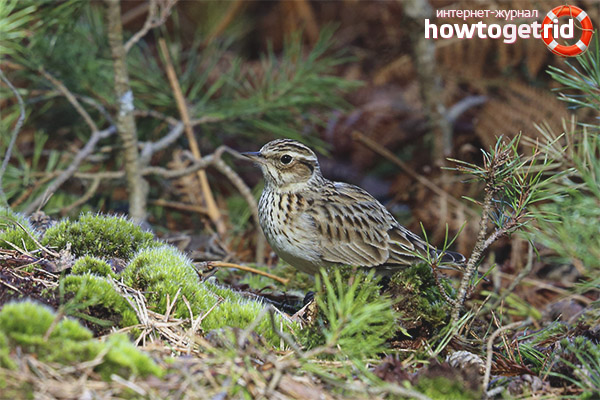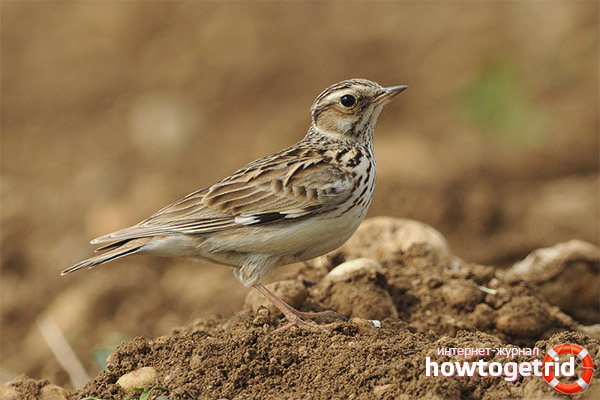The content of the article
The forest lark is a small bird in the family of larks, a group of passerines. The more familiar name of this bird to the inhabitants of our country is as a yule. In size, this little lark is more similar to an ordinary sparrow. The body length is up to 18 cm, the wingspan of the bird reaches 34 cm. Body weight - no more than 32-35 grams.
The characteristic color of the plumage for this bird species is saturated brown tones. Like most species of its relatives, the forest lark also has a typical crest on the head, formed by raising the head plumage. Outwardly, it is very similar to its relative, the Lark, but has a shorter tail. The bird is very cautious, often flies, sitting on tree branches, shrubs, which is not typical behavior for most representatives of the lark species.
The flight of birds of this species has its own characteristics - being in the air, it flies unevenly, undulating. Due to some roundness of the wings, the flight of birds of this species is similar to the flight of small woodpeckers.
The main description of the species
The color of the feather is dark brown, has a wide rim of yellowish color on the edges. At the bend of the wing, the lark has a combination characteristic of representatives of this species, consisting of several light and dark spots. Such a pattern is formed by combining the coverts of the brush. The tail feathers also have an original color - all feathers are dark, except for the middle and extreme pair, which have a yellowish-brown tint. The paws of this small and brisk bird are pale pink.
It differs from most related species of Larks of the Yule in that the bird has a characteristic pattern on its head - rather long whitish eyebrows, the end of which falls to the corners of the eyes, as well as chestnut spots on the cheeks.
Bird Voice Features
Forest lark trills are characteristic for this type of bird, quite loud and melodic, completely unlike songs performed by related species, are well remembered by ear.
In fact, Yule’s song is a set of melodious and beautifully whistling phrases that are sung by the bird at the same time as the volume increases and the tone decreases.
Most often, the yule sings its songs while in the air, slowly soaring in a spiral, or sitting on top of small bushes or young trees.
Species distribution

The most common population of this species of early bird in the vast territory of western Eurasia, northern Africa. Note that the forest lark is a relatively rare bird species, while the population is constantly decreasing. The main place of wintering is the Middle East, southern Europe, North Africa.
Lifestyle features
In fact, the presented species of the Lark family is the only one that is closely related to the woodland (natural habitat). As a rule, for nesting, these birds choose an area that combines dense forest vegetation and light clearings with sparse grass.Often you can meet a forest lark in places of deforestation, in areas overgrowing after a forest fall. Most of all for living, he prefers light forests (pines, oaks) with fairly poor sandy soil.
The average number of eggs in a clutch is up to 6 pieces. Their color is light pink with a characteristic dark speck. The duration of the planting period of the future offspring by the female is about two weeks.
Hatching chicks have a thick downy outfit of light gray color, yellow pharynx. A typical sign of this species is the presence of 3 dark spots in the chick's tongue.
In the warm season, the yule eats itself and feeds the hatched offspring with small invertebrates. However, the diet of this bird species also includes grass seeds and some cereal.
Video: Lark (Lullula arborea)










Submit